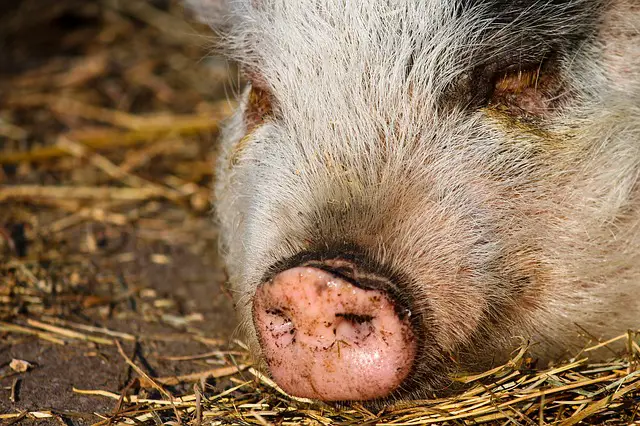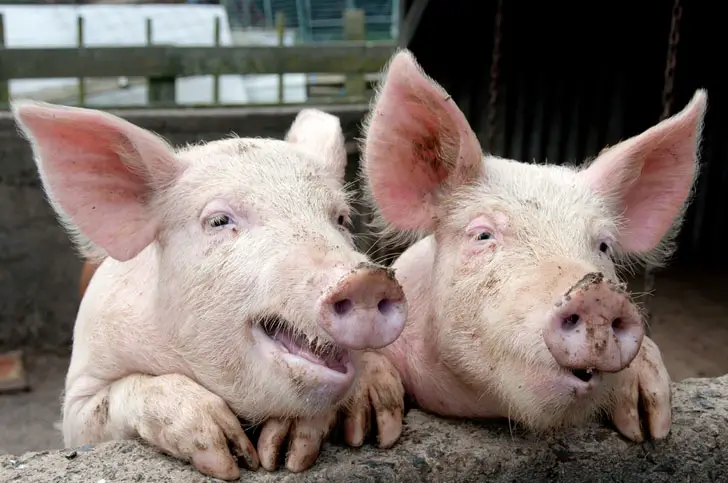We see pigs with such big noses that we wonder what these animals use when they’re drinking water; do they use their noses or their mouths?
Does a pig drink through its nose? But just like every other cattle in the yard, these pigs drink through their mouths. It might just seem like they drink through their noses because they have such big ones. These pigs inhale mouthfuls of a liquid, commonly water, and gulp them down. These pigs also need as much water as possible, that’s why they tend to gulp down lots of water in one go.
While we have debunked that pigs don’t drink through their noses, their snouts and a lot of their other body parts have interesting things up their sleeves as well. They’re so much more interesting than just how they drink their water.
Drinking Patterns
Just like humans, pigs have a certain water requirement that they must drink to remain healthy and hydrated. Depending on the age and the activity that a pig is engaged in, it should have a sufficient amount of water intake every day.
During hot days with temperatures reaching 426 degrees Celsius, these pigs usually drink water around 8 to 9 am, according to the Pig Site. These pigs also have a second round of drinking around 5 to 8 pm when it’s close to sleeping. They usually start and end their day drinking water so they can start and sleep hydrated.
Weaned pigs need to drink half a gallon every day, while growing pigs need about 1.5 gallons every day. For pigs that are used to breed, they should be able to drink 3 to 4 gallons every day.
Lactating females must drink about 5 to 6 gallons every day. These females drink as often as possible because their milk’s primarily water. This is very important so that that these vulnerable pigs remain hydrated, especially that they can subjected to various health concerns.
You can also use their daily water intake and pattern as a way to monitor if they were hit with common pig sicknesses such as the swine influenza. This is a vital factor since unattended sicknesses may lead to death.
If there’s a change in their water intake, whether dropping by a certain percentage or gradually as days progress, it could be an indicator of bad health.
But there’s also a problem with pigs consuming too much water. It’s called the Psychogenic Water Consumption. Pigs drink gallons and gallons of water at a time, and sometimes, they just stand and urinate while they’re still drinking. One way to avoid this one is to avoid giving them too much water and observing when they drink.

Other uses of its nose
Other than tricks, these pigs have such powerful snouts that can also be quite useful. Even if they have poor eyesight, their snouts can easily compensate for that area. Their snouts may not have eyes, but they can definitely find something,
They have snouts that are quite sensitive and have a strong sense of smell that can find just about anything. Whether they’re domesticated or wild pigs, they can use their snouts to find and dig up food.
Speaking of digging food up, these pigs are able to use their snouts to look for food underground, like how they were trained to back in the Babylonian days. They were used to look for root plants and even expensive truffles underneath trees.
However, this practice was stopped because pigs were capable of damaging these precious ingredients which caused the price to hike up. As much as these pigs were good at finding them, they were also good at destroying them to the point of bringing their price down.
Their snouts are also very useful in identifying other smells that helps them distinguish new and different pigs. Even without eyes, these pigs are able to identify other pigs just by the use of their olfactory senses.
That’s why these pigs also mark their own territories with their own scents because they know other pigs can smell these, as well. Since pigs are also capable of communicating through their saliva and urine, their snouts also play a very important role in that.
So, if they don’t use their noses to drink water, they use it to find things that are not just useful for the pig but also useful for humans as well.
What else does a pig drink
Even when they were still piglets, they already started with feeding on liquids instead of solids. This shows that pigs already have experience, and might still be accustomed to drinking liquid food more than solid foods.
With the advancement of technology, pigs won’t just drink water but they can also drink liquid feeds. Developers of this feed have found a way to reduce the costs of feeding them. Though this is a system that requires a large start-up cost and a meticulous feedings procedure.
A benefit that growers get from these liquid feeds is that there is a significant increase in pig consumption. According to Wattagnet, pigs consume about 12% more when they’re fed with liquid feeds than dry feeds. Sometimes, it can even reach up to 33%. This is due to the form in which food is being taken in. generally, it’s easier to take in liquids more than solids.
Other than that, the costs of liquid feeds is also significantly lower in the long-run because these feeds are recycled by-products from the human food industry. By just recycling the food, costs are significantly lower because you don’t need to produce new ones.
These liquid feeds also have nutrients and essential ingredients that can be beneficial for it. with liquid feeds, digestibility is also increased because it’s in liquid form and not in solid form. Digestibility can also be improved through the enzymes that are present in the liquid feed.
Even through the fermentation of the liquid feed, certain bacteria that can cause problems for the pig can be eliminated, proving to be a better option for growers who want don’t want to deal with problems.
There are a couple of common liquid feeds available in the market. Starting with cheese whey, since it’s a common by-product in any part of the world. It contains protein and lactose but can also contain salt that might not be as healthy for the pig.
There’s also liquid wheat starch that is made from both start and gluten from wheat that’s also quite high in protein. Potato steam peel is also a good liquid feed. Sometimes, liquid feeds can also be skim or whole milk. These kinds of milk are high in protein and lactose.

How other animals drink
As humans, we might be weirded out by how animals drink. Though others may seem understandable, some are just out of this world.
An interesting thing is that cows consume more water than pigs do. These cows can consume about a 100 gallons of water every day if she’s milked for production. This number can go up on hot days.
Starting with man’s best friend, dogs look normal when they drink water but what happens in a dog’s month requires a lot of work. These dogs form cups using their tongues to get water. A research from Virginia Tech shows that these dogs form cups that are towards them so that they can drink easier.
Another animal that doesn’t look like it does much work is the snake. These animals don’t use their tongue but their mouths. With mouths that are capable of expanding to accommodate even the largest preys, it can also absorb water like a sponge. The muscles in the snake’s mouth push the water down into their body so that it hydrates itself.
Smaller animals like bugs don’t use their tongues, but use their straw-like mouths. One example would be the butterfly that uses its long proboscis to suck in nectar that it needs. While this seems kind of normal, other animals don’t drink water but drink other bugs. Since this is their food, they drink it instead of munching on it.
These carnivores get close to other bugs and just pierce their mandibles in the sides of the bug. Once pierced, the bug sucks dry the poor prey. This animal is the lacewing. These animals generally take a few minutes before they finish their sumptuous drink.
Related questions:
These pigs can go 24 hours without water but they also need to be given water immediately. They can lose a lot of weight if they go without water for a long time.
As much as they like drinking water, they also like swimming in water, or specifically mud. They like to keep themselves cool because they do not have sweat glands.
If they don’t have access to fresh water, they may be forced to drink the liquids that are readily available to them to quench their thirst. Whatever that liquid may be, if they’re thirsty, they will be forced to drink anything.
